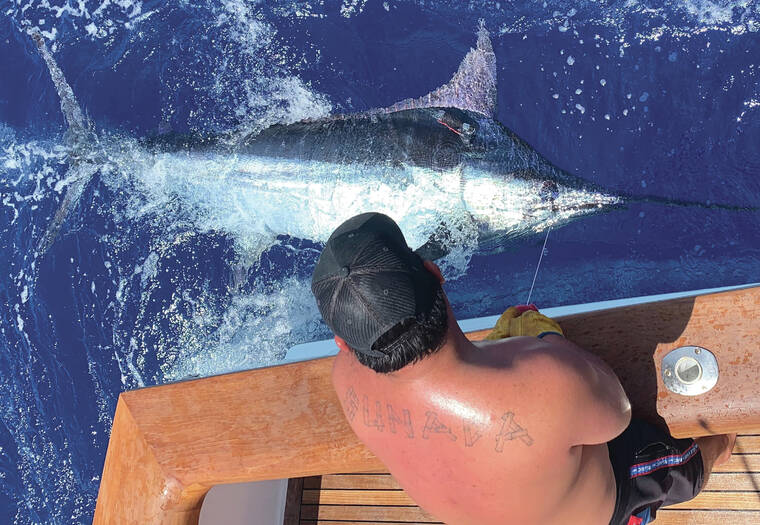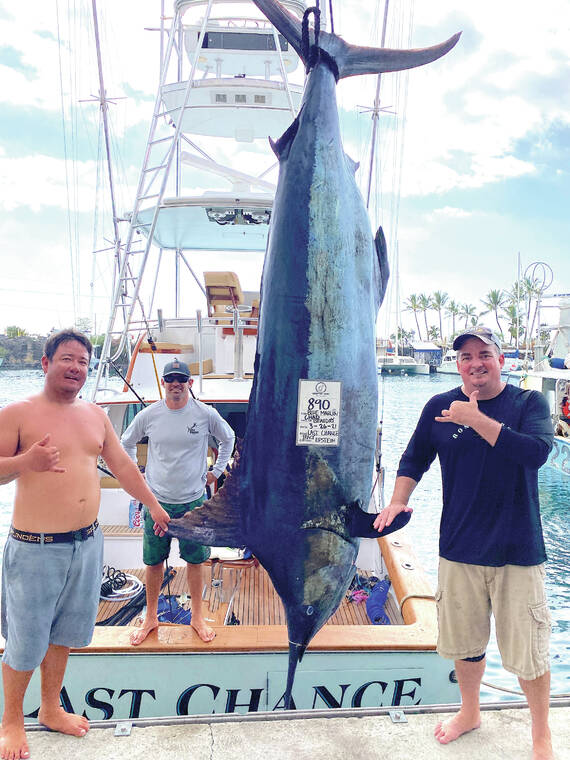The Vibe
Around here, people fish for all sorts of reasons. Of course, islanders fish to eat. Hawaii has a long history of folks along the coast trading fish to farmers and hunters up on the mountain. The introduction of a cash economy added bureaucracy to this simple ancient system in the form of a license. Hawaii is now unique in the USA in that folks who are primarily fishing for their food or fun, can also sell fish to offset expenses.
To lots of folks who fish, food and trade are not the major incentives. Folks who don’t go fishing often might just be looking to enjoy a day on the ocean. Fish are bonus. Many who fish a lot approach it as others approach golf, triathlons, tennis or what have you – it’s their sport. They want to be good at it.
In the world of marlin fishing, the Holy Grail is a marlin weighing 1,000 pounds. Some guys never come close, even after they have spent ginormous piles of money and years in their quest. You can’t buy a marlin. You can buy the best boat, tackle and electronics, hire the best crew and scour the oceans wide, but that won’t insure success. Having a good vibe on board is fundamental to success. Those who know, know.
Granders are a given sign of success, but rare. Some “fish for numbers” and success may be 100 marlin in a year. Success for others is winning tournaments. A smaller group want their name in the world record book. Some guys, like Chad Beaudry just like it all.
Chad seems to approach each day with an overall sense of fun. Sure, he wants a grander. His largest is 890 pounds. He also loosely keeps tabs on his “numbers.” When it comes to tournaments, he’s as competitive as anyone. He and his team on “Last Chance” are usually in the top five of the Hawaii Marlin Tournament Series each summer. Unlike some of the John McEnroe types in tournaments, he handles both sides of the “thrill of victory and agony of defeat” in pretty much the same way – with an admirable calm.
Well, why not? Chad worked on the floor of the Chicago Board of Trade, and if you aren’t familiar with the craziness that goes on there, watch the Eddie Murphy movie, “Trading Places.”
“Finding the edge in a trade refers to that tiny sliver that separates a trade from being a winner or a loser. Fishing tournaments can be like that,” Chad said, and he knows this first-hand.
At the Kona Throw Down tourney this summer he was sitting in a pretty good position, with four marlin tagged, and 800 points – all caught on the first day of competition. The purse for the Most Points per Day was just over $32,000.00.
After the call of stop fishing, a boat that had been fishing at the far end of grid finally arrived at the dock to weigh their fish, estimated to be 575 pounds. They also had one marlin tagged, good for 200 points.
“Wild Hooker” tied up at the dock, their fish was hoisted and it settled the scale at 600.5 pounds. Combined with their 200-point tag, they put a total of 800.5 points on the scoreboard, nudging “Last Chance” completely out of the $32,000.00 day money – by half a point!
That just might be the bad side of the “edge” analogy Chad said occurred in both tradings and fishing tournaments. When Tournament officials called and told him that “Wild Hooker” had one half of one point more than he did, Chad calmly said, “Of course they do,” as if he’d seen this type of thing a hundred times before.
Tournament season is over now. Chad along with Capt. Tracy Epstein, crewman extraordinaire Miguel Castanada and various friends on “Last Chance” are still getting out a few days a week, looking for a grander, with an eye on the 100 marlin mark for the year. He thinks he’s somewhere around 80 now. Instead of obsessing over those two signs of success, Chad and company have found another way to have fun while waiting out a grander. They’re contributing to marine science by setting marlin free with high tech devices called Pop Up Satellite Archival Tags (PSATs) attached. PSATs are mini computers designed to capture an array of data, wherever the fish goes.
PSATs look like a black cigar with an egg on one end. An antennae sticks out of the far end of the egg and a heavy nylon line is attached to the other end of the cigar. At the end of the line a dart is attached. Inside the cigar is a mini computer. When they get a marlin to the boat, the team jabs it with the dart and then sets it free to swim away with the device hitchhiking along. The computer is programmed to burn the nylon line at a certain date – hundreds of days later – freeing the device from the fish.
Once free, the egg shaped float pulls the device to the ocean surface where the antennae transmits the archived data to a satellite, which then beams it down to scientists. Scientists can extrapolate where the marlin went over the course of the study period, see water temperature and depth data for each day, and gather various other data they programmed the computer to archive.
Chad and the crew on “Last Chance” are not the first to participate in the PSAT program, but one of his fish swam farther than any other blue marlin this year – 1020 miles. They also deployed the most recent PSAT this past Saturday. It is now hitchhiking on a healthy 500-pounder.
PSATs were first deployed in Kona back in 2002, when many skippers in the fleet helped deploy 38 PSATs during HMT Series tournaments. You can see the tracks of those fish here:
Of course, technology has improved since then, and you can view video representations of recent tracks by logging on to The IGFA Great Marlin Race page:
https://igfa.org/the-great-marlin-race/



